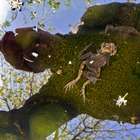Periscopedune
Posted Nov. 17, 2017 by Theun KarelseThe islands of the Wadden are situated in an intertidal zone in the southeastern part of the North Sea called Waddensea. The island of Terschelling is the setting for IMRAMA, an investigation initiated by Jan de Graaf and Jeroen van Westen into the nature of this UNESCO world heritage site. The fieldwork of IMRAMA sets out to "look at - looking at the Waddensea". Theun of FoAM Amsterdam has been ivited to participate in the fieldwork on the island.
The IMRAMA organisers have identified keywords and fieldposts in the area of the island of Terschelling. Theun will explore the 'Periscope Dune' fieldpost which is related to the keyword 'sensorscape'. Or in the words of Jan de Graaf; "the Pericope Dune irelates to the idea of the dunes looking back at us."
Theun set out on a first introducing fieldsession with four fieldwork experts with an encyclopedic knowledge of intertidal dynamics and the natural history of the Dutch landscape in general: Jan de Graaf, Jeroen van Westen, Marinus van Dijke and Gerbrant van Vledder.
The Periscope Dune fieldpost relates to a classic comicbook story Kapitein Rob en het geheim van de Boschplaat (1948), about a naval hero in the genre of Captain Nemo and James Bond, defeating a sinister German plot after being captured by a drone-like machine, building his own set of scuba-diving gear from wreckage. The main lesson: vigilance. Our landscapes are full of eyes that monitor us 24/7.
Jan speaking on the role of the Waddensea in early spy literature:
“A bestseller of the genre of popular geopolitics was the novel (pulp fiction some say) of Erskine Childers, ‘The Riddle of the Sands’ (1903). Often called the first modern spy novel: two men, camouflaged as sailing tourists, started in the Baltic Sea and then crisscross the German and Dutch Wadden Sea. Our protagonists thwart a German raid of England when they discover a secret fleet of invasion barges assembling between the North Sea Islands of Ameland and Terschelling. Pulp or not, in the real First World War, Childers was recruited by the British Naval, as leading ‘eye’ in the aerial reconnaissance, lending out his artistic gaze (the eye of the spy) for reading aerial pictures, the base for accurate mapping the intertidal sandy coasts of that Wadden Sea.”
Jan de Graaf, The culture of sandy shores, in Techno-ecologies (Nida 2015).
Created: 15 Jul 2021 / Updated: 15 Jul 2021




